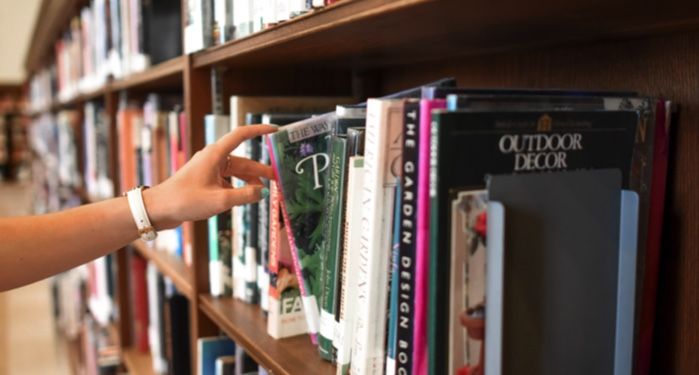
Top Tips For Weeding When You’ve Got 100 Other Things To Do
Weeding a library is actually a lot like deadheading a flowering plant. Anything broken or withered needs to be removed to make space for healthy, fresh growth. The process asks librarians to look through their collection, take books off the shelves, remove them from circulation, and then dispose of the books in some way. Simple, right?
Well, no. This process is complicated for many reasons, not the least of which is the emotional work of getting rid of books in a profession where every word and every page has to be fought for. However, a weeded library is easier to maintain and leaves space for patrons to find engaging books without being overwhelmed by outdated materials. It is the most important type of decluttering, without the simplicity of a Marie Kondo mantra, but if there’s anyone who can get the job done, it’s librarians.
What To Know Before You Start
The tips I’m sharing below are used in my elementary school library, in a public school where I am the sole person in charge of collection development and maintenance. This allows me to make weeding judgment calls on the fly. If you work with a group of people, common weeding guidelines would need to be laid out. These might include a cut-off year (e.g. Excluding classics, we don’t keep any books published before 1970), or circulation stats that show how often the book is actually checked out. In certain libraries, librarians might be asked to share their weeding justification with a department head or even city council. Before you jump into your weeding challenge, these are all good things to consider.
If you’re in a new space or working in a new position, I would suggest suppressing the urge to weed too much in the first few months. In a school, I would give it an entire year. This lets you see how the collection is used and what events might pop up that would explain why you have 13 copies of Charlotte’s Web when typically one copy would do. See? It really isn’t simple to stay on top of weeding. There is so much to consider and it’s far from the only daunting task librarians face daily. Without further ado, here are some of the tips I use to keep my head while keeping my library weeded.
Gather Your Materials
When I first started weeding in my library, I would put discarded materials on a “free books” table so my students could give them a new home. I quickly became overwhelmed when dozens of discarded books started showing up in my book drop. Even though I had used a red “DISCARD” stamp inside the book, anyone in the school would find a book with the barcodes and labels used by my library on the cover and toss it in the book drop where they thought it belonged. The solution? A simple thick black X through the barcode to make it clear it’s not coming back.
Now, the specific black poster marker and the small box with our DISCARD stamp have a dedicated spot next to the computer I use for circulation. This sounds small, but it makes a world of difference in accomplishing the rest of my tips.
Start Small
When I officially made one of the goals an overhaul of the collection, I started out with a calendar to track the time I dedicated to weeding. Starting in the picture book section, I told myself I would take just 15 minutes daily and hit just one shelf. Not a set of shelves! A single rectangular box that holds 30–60 books. I’d flip through, weed out anything that needed to go, and process the entire stack of weeded books (remove from the catalog, mark as discarded, and leave the books on the free books table). When I was on top of things, this was incredibly effective and very satisfying.
Hit High Impact Areas First
If you’re not planning a complete overhaul, think about where the weeding can have the most power. If there is a particular section that is overstuffed, start there. If you can’t really think of anywhere, check out your technology and science sections. This is information that can get outdated pretty quickly. I inherited a former middle school library, and some of the reference materials about countries had old names and boundaries — obviously this was easy to remove.
Weed As Books Come Through Circulation
This is a recent addition to my weeding arsenal, and where it comes in handy to keep the materials needed right by my side. When I’m checking books back in, I keep my eyes peeled for any books that aren’t going to make it through one more check out. Especially with the popularity of certain graphic novels, it’s very common for books to become over-loved. I will fix MANY a torn page or shaky binding, but I’ve started to become more aware of when a book needs to be retired. Instead of saving it up for a weeding session, I tend to process it right in that moment. If the book is totally shredded, it’s in the recycle bin the next time it leaves my hands.
Weed While You’re Shelving
Remember when I said I set an official goal and committed to one shelf a day? Well, in my school library, where I am teaching seven classes a day as well as developing and maintaining a collection, running book fairs to fundraise my budget, serving on committees to develop curriculum, co-running the STEM club, and overseeing testing for my administration…my plan fell apart. There were no more 15 minute blocks to snatch up. But the weeding still has to happen! I started weeding while I was shelving.
When moving through the stacks replacing books, I will often check a shelf and see if there are doubles or books that look noticeably older and out of place. While shelving a single book truck, I might weed out 5–10 books. I then quickly process and remove them as part of the shelving routine. Even though its harder to make time for weeding as a separate event, I am still working towards the goal of keeping the shelves fresh every time I’m in the stacks.
Hopefully you’ve found some tips that can help you with the sometimes overwhelming process of keeping the library weeded. Need more weeding inspiration? Check out this article on the importance of weeding. Any good tips I missed? I would love to hear them! Happy weeding, and happy reading.












